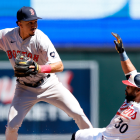
The Los Angeles Dodgers have to ask themselves the following question between now and Wednesday's game against the Cincinnati Reds: how much do we believe in Noah Syndergaard? How the Dodgers answer that question will determine whether or not he makes his next start for them.
When Syndergaard, 30, signed a one-year pact with the Dodgers over the winter, there was an expectation that he was going to the perfect place to reinvent himself. The Dodgers are considered to be the best organization in the league at helping players get the most from their games. Last season alone, they guided Andrew Heaney and Tyler Anderson to comeback years that led to them signing more lucrative deals elsewhere.
So far, the Dodgers have not been able to work the same magic with Syndergaard. Through 11 starts, he's amassed a 6.54 ERA (68 ERA+) and a 3.89 strikeout-to-walk ratio. On Tuesday, he surrendered five runs on seven hits (including three home runs) in a five-inning start versus the Washington Nationals. Afterward, manager Dave Roberts was noncommittal about Syndergaard making his next start.
"Um, I don't know. The hope is that he does," Roberts told reporters, including Juan Toribio of MLB.com. "Right now I just don't want to answer that question."
Oof. At minimum, we feel that Syndergaard's struggles aren't from a lack of trying. To wit, we here at CBS Sports figured we would highlight three of the notable tweaks he's made during his time with the Dodgers while assessing if the Dodgers should stand by his side heading forward, or sever the relationship now and give the starts to someone else.
Let's get to it.
Noah Syndergaard, Wicked 93mph Two Seamer 🤢
— Rob Friedman (@PitchingNinja) April 25, 2023
16" of run pic.twitter.com/rFeWq3wFou
1. Different fastball location
When you think about prime Syndergaard, you probably think about him overpowering hitters with his fastballs. He's not capable of doing that anymore. His average fastball velocity this season is 92.3 mph, down 1.5 mph from last season and 5.3 mph from the 2019 campaign. Syndergaard has attempted to offset the loss in oomph by adding nearly an inch of horizontal break and another in rise, but it hasn't worked out well. The opposition is sporting an .847 OPS so far this year against his heaters.
Syndergaard's fastball shape is part of his problem. There's a new school of thought that pitchers should want some kind of separation between the amount of induced vertical and horizontal breaks they achieve. The thinking is that pitchers who have a small gap (or no gap whatsoever) have fastballs that are easier to track. Take a look at Syndergaard's net break over his last five full seasons:
| Season | MPH | IVB | HB | Net break |
|---|---|---|---|---|
2017 | 98.1 | 15.7 | 13.8 | 1.9 |
2018 | 97.4 | 13 | 11.2 | 1.8 |
2019 | 97.6 | 12 | 10.2 | 1.8 |
2022 | 93.8 | 11.6 | 11.3 | 0.3 |
2023 | 92.3 | 12.5 | 12.1 | 0.4 |
That is, to paraphrase former manager Joe Girardi, not what you want. Don't take our word for it though. Austin Marchesani, now an analyst with the Los Angeles Angels, wrote in December 2021 that "there are ways to work around [a dead zone fastball] such as throw harder than average or avoid throwing low in the zone as often." Syndergaard isn't throwing as hard as he used to be capable of throwing. He has, however, tried to compensate for that by elevating his heaters more often:
| Season | Upper half% |
|---|---|
2017 | 47% |
2018 | 46.7% |
2019 | 58.4% |
2022 | 53.7% |
2023 | 57.8% |
We don't have to tell you that it hasn't helped. Without a good fastball, Syndergaard has had trouble getting the rest of his arsenal working -- even the new pitches he's introduced this season.
2. New cutter
At the peak of Syndergaard's powers, he would chuck high-octane fastball after high-octane fastball. When he wanted to give batters a different look, he often went to his slider. That pitch, as it was known then, no longer is part of his arsenal. Rather, he's replaced it with a new offering that pitch-classification algorithms have deemed a cutter.
Noah Syndergaard, Nasty Changeup and Slider. 😨 pic.twitter.com/gZtDU18wkR
— Rob Friedman (@PitchingNinja) April 2, 2023
That is, in our estimation, a fair designation. Compared to Syndergaard's slider from last season, his cutter comes in faster (about 5 mph), with a great deal more backspin and four inches fewer horizontal sweep. It's clearly not the same pitch that he used to throw.
Syndergaard has essentially inserted the cutter in place of his slider in terms of his usage rate, too. Whereas he threw 22% sliders in 2022, he's thrown 19% cutters this year. The results haven't been great. Batters are hitting .359 off the pitch with a .538 slugging percentage. The cutter has generated just 18.5% whiffs, one of the lowest among its type in the majors, and less even than his scrapped slider's 22.5% mark last year.
3. Other alterations
Syndergaard has tinkered with more than his cutter. He started throwing a new curveball during the spring that features more backspin and slightly more horizontal break. He also toyed with a new splitter his last time out, according to Marquee player development analyst Lance Brozdowski. Syndergaard's splitter features more drop and less spin than his changeup, all the while coming in at a similar velocity.
It's to be seen if Syndergaard continues to experiment with the splitter. At present, those two pitches account for fewer than 12% of his total offerings this season, suggesting that he doesn't have a ton of faith in the new-look curveball despite some decent results -- batters have hit .238 against it to date, albeit while seldom swinging and missing.
Should the Dodgers hold out hope that Syndergaard can become a tolerable starter? It's hard for us to be optimistic based on the number of changes he's already made without finding much in the way of success. We suppose that it can be taken as a good sign that he continues to work on his arsenal, exhausting all means of getting better. But it's hard to make wholesale changes in-season, and it's not clear whether he'll find something that clicks. Even if he does, there's no guarantee that he'll improve enough for a contender to deem him worth rostering.
Syndergaard may make his next start. He might stick in the rotation a few more turns through. Beyond that? It's hard to envision him ending the season with the Dodgers in any meaningful capacity.






















